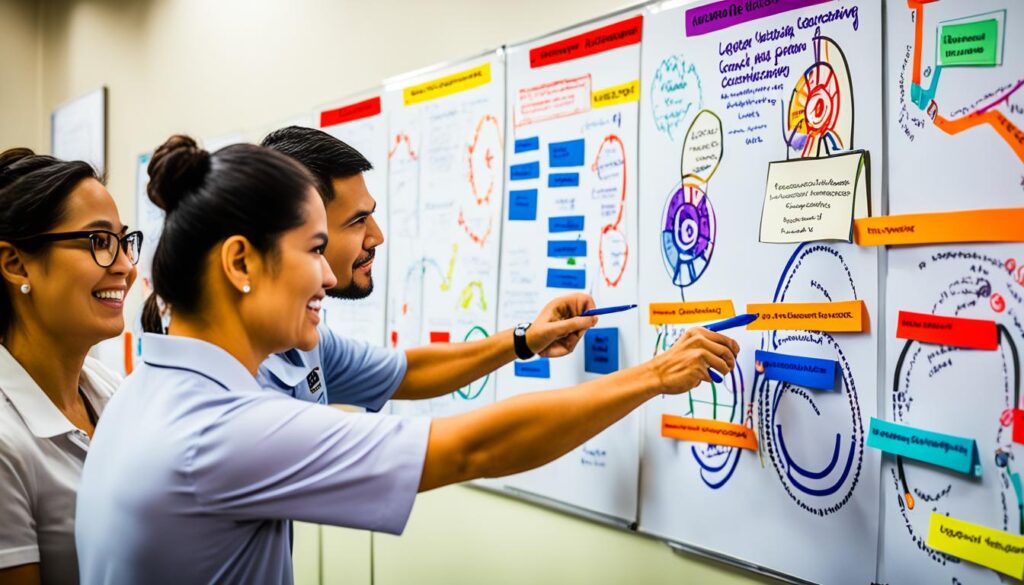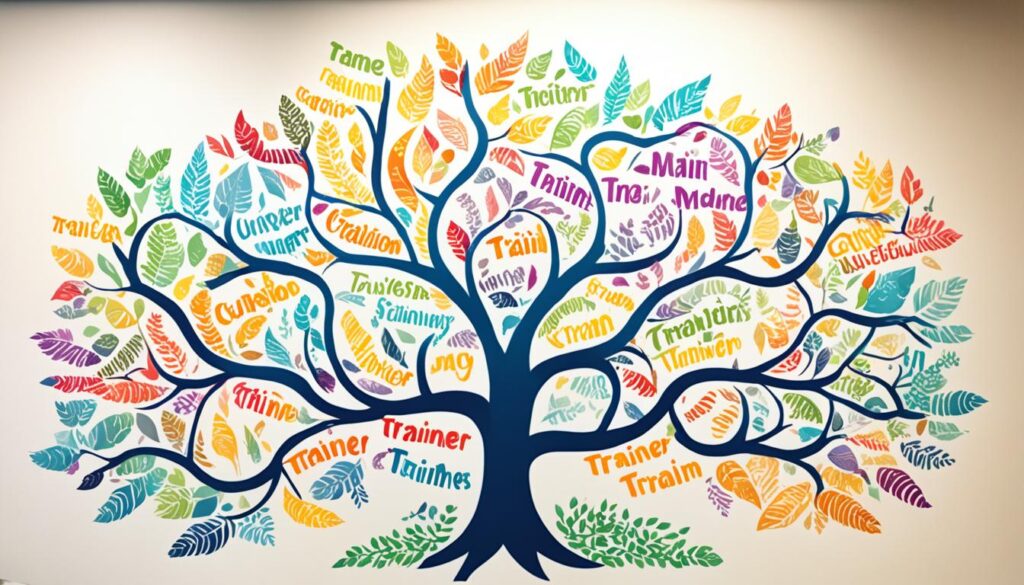Ever wonder how some companies always have top-notch training programs? The trick is a great train the trainer program. In this competitive world, developing your trainers can really boost your business. It helps your training be better and your company more successful.
Developing a great train the trainer program is more than just sharing knowledge. It’s about making learning a constant part of your company’s culture. You give your trainers the skills, knowledge, and tools they need. With these, they can lead training sessions that truly help meet your organization’s goals.

This guide will show you the main steps and ideas for designing a successful train the trainer program. We cover everything from the model to finding your next trainers. You’ll learn what’s necessary to make your trainers into effective educators.
Let’s dive into the train the trainer world together. We’ll see how it can make the most of your company’s training work. Get ready to learn about powering up your training efforts.
Key Takeaways:
- An effective train the trainer program can enhance training effectiveness within your organization.
- Investing in trainer development creates a culture of continuous learning and growth.
- Understanding the train the trainer model is crucial for designing an effective program.
- Identifying potential trainers with the right skills and characteristics is essential for program success.
- Creating a well-structured curriculum and incorporating adult learning theory is key to optimizing learning outcomes.
Understanding the ‘Train the Trainer’ Model
The ‘train the trainer’ model boosts your team’s skills in training. It focuses on teaching chosen workers to be great trainers. This way, your team can offer training that fits your company perfectly.
The Importance of a Train the Trainer Approach
This model has many benefits. It lets you use your own team’s knowledge about your company. Training by your team means it’s more relevant and effective. It also helps your team members grow in their careers. It makes learning part of your company’s everyday life.
Key Characteristics of an Effective Train the Trainer Program
For a program to work, it must teach your trainers how to be great at teaching. They’ll learn to make learning fun, explain things clearly, and get everyone involved. A good program also creates a friendly place for learning, where sharing ideas is key.
It’s also important to teach based on how adults learn best. Customizing the training for adult learners helps them remember and use what they learn. Don’t forget to regularly check how the program is doing and improve it as needed.
Getting the ‘Train the Trainer’ model right helps your company grow. It brings a spirit of learning into your workplace. This leads to better training, and in the end, more success for your whole team.
Evaluating Your Organizational Training Needs
To make a successful train the trainer program, you must start by learning your company’s training needs. It’s key to look at what skills your team lacks and what kind of training they need. This way, your training plan can fill the gaps and meet specific needs.
You need to check what skills and knowledge your team already has. This helps you see what areas need work. Then, you can pick the right training to boost their skills.
Here are some steps for a good evaluation:
- Identify the desired outcomes: Know what you want training to achieve for your organization. This sets the path for your evaluation.
- Collect data: Use surveys, talks, and reviews to gather information on your team’s strengths and weaknesses. This shows where they need training.
- Analyze the data: Look at the info to find common weak points. This guides your focus on what needs improvement.
- Conduct a skills gap analysis: Compare your team’s current skills with your training goals. See what skills are missing. This tells you what training they need.
- Consider future needs: Think about where your industry is headed. Consider what new skills your team might soon need. This keeps your training plan ready for the future.
With a detailed look at your company’s training needs, your train the trainer program will be spot on. It will help reach your company’s big goals.

Identifying Potential Trainers Within Your Company
Finding the right people to train others in your company is crucial. This step is key to making your training program work well. It also boosts how effectively your company trains its people.
Skills and Characteristics of Successful Training Facilitators
Great trainers have special skills and traits. These help them teach well and connect with people they’re training. Good trainers should have these qualities:
- Subject Matter Expertise: They know a lot about what they are teaching. This makes the information they share accurate and useful.
- Strong Communication Skills: Trainers need to explain things clearly. They must make hard concepts easy to understand.
- Adaptability: Every group of trainees is different. Trainers should be able to change their methods to fit the needs of their audience.
- Empathy: Understanding their trainees’ perspectives helps build a good teaching relationship. It makes learning a more engaging experience for everyone.
- Problem-solving Skills: Challenges during training happen. Good trainers can solve these problems quickly, keeping the training on track.
These skills play a big part in how good a trainer is. They also help your training program succeed.
Assessment Methods for Selecting Internal Trainers
Picking the best internal trainers means using the right ways to test them. This ensures you choose the best for the job. Here are some ways you can do it:
- Performance Evaluation: Look at what trainers have done in their current jobs. This shows if they’re ready to teach others.
- Interviews: Talk to them to see if they’re good at explaining things, know their stuff well, and can adjust when teaching.
- Simulation Exercises: Give them mock training scenarios. This tests how they handle teaching different topics and people.
- Peer Recommendations: Listen to feedback from colleagues and bosses about the trainer. They can reveal strengths and areas for improvement.
- Training Delivery Demo: Have them give a short training session. This shows their teaching and presentation styles.
These methods help you pick the best trainers. They increase the chances of your training program being a success.
Train the Trainer: Curriculum Development
Creating a strong training program begins with the curriculum. This curriculum should be thorough and clear. It ensures that your trainers have all the knowledge and skills they need.
Adult learning theory is key when you’re designing the curriculum. This theory focuses on how adults learn best. Embracing it makes your training engaging and relevant to your trainers.
One important aspect of adult learning is the need for practical examples. Adults learn best when they can see how knowledge applies to real life. So, by including real scenarios in your lessons, you make the learning more meaningful.
Also, adults like to be active in their learning. They prefer to dive in and participate. So, add group discussions and interactive tasks to your sessions. This approach boosts their learning and retention of information.
Incorporating Adult Learning Theory
Adult learning theory is essential for your training program. It acknowledges that adults learn differently from children. By using this theory in your curriculum, you make learning effective and enjoyable for your trainers.
Adults learn best when they understand how their learning directly applies to their work or life. Thus, include practical examples and case studies in your material. This strategy helps them grasp the content more deeply.
Adults also like to be in control of their learning process. They enjoy a more hands-on approach. Therefore, interactive exercises and discussions are important to include. This way, trainers get to apply what they learn right away, making the training more valuable for them.
Structuring the Curriculum for Optimal Learning
The way you organize your curriculum matters. It needs to flow logically, guiding trainers through their learning steps. A well-structured curriculum helps trainers build their skills systematically.
Setting clear objectives for each lesson is crucial. Know what you want trainers to learn or do by the end of a session. Make sure every part of the lesson focuses on these goals.
Everyone learns differently. So, use a mix of teaching methods. This might mean combining videos, readings, and practical exercises. Variety keeps trainers engaged and helps everyone learn in their own way.
Make sure your curriculum is easy to follow. Use clear headings and a logical structure. This makes finding information a breeze for your trainers, making their learning experience better.
By applying adult learning theory and designing a clear curriculum, your training program can be very successful. These steps help your trainers learn well and prepare them for their roles effectively.

Essential Training Techniques for Trainer Development
Developing trainers is key for a better train the trainer program. It ensures trainers are ready to make their sessions engaging and powerful. We’ll look at some great tips to boost your trainers’ skills.
1. Interactive Exercises
Using interactive exercises in training is a winning move. It gets learners involved and learning actively. Group talks, hands-on work, and solving problems together make learning fun and effective.
2. Role-playing
Role-playing is more than fun; it’s a solid training tool. It lets trainers practice handling real-world issues in a safe space. This boosts their communication and problem-solving, plus their empathy for others.
3. Case Studies
Case studies give real-life situations for deep discussion. They improve critical thinking and decision-making. By studying cases, trainers learn to think from different angles and handle challenges better.
4. Multimedia Presentations
Using slides, videos, and infographics makes training more interesting. It reaches diverse learners and simplifies complex ideas. It leaves a lasting impression on trainees.
5. Demonstrations and Practical Application
Demonstrating skills live and offering hands-on practice is essential. It gives a clear example to learners. They get to try what they’ve seen, building their skills with help from the experts.
These methods sharpen your trainers, readying them for powerful sessions. Blend interactive exercises, role-playing, case studies, multimedia, and hands-on practice. This mix arms your trainers to effectively develop others within your organization.
Facilitating Engaging Presentation Skills Workshops
In the train the trainer program, leading engaging workshops for presentation skills is key. It helps trainers become more effective. These sessions give trainers skills to make their sessions engaging and promote deep learning. We will discuss how to make training delivery dynamic. Plus, we’ll show why practice and feedback are crucial for trainers to improve their presentation skills.

Techniques for Dynamic Training Delivery
Keeping the crowd engaged is crucial. Effective knowledge transfer depends on it. Here are some tactics trainers can use in their workshops:
- Storytelling: Share stories that engage listeners. This forms a connection and boosts how much they remember.
- Visual aids: Showing charts, graphs, and videos can simplify complex topics and help people remember them.
- Audience engagement: Get the audience involved through activities, discussions, and answering questions. This makes them understand the topic better and creates a team-learning vibe.
Practice and Feedback: Keys to Mastery
Practice and feedback are essential for trainers to hone their skills.
They need a safe space to try their presentations and build confidence. Getting feedback from both peers and experts is important. It offers valuable tips and helps trainers get better.
Presentation Skills Workshop Schedule
| Session | Duration |
|---|---|
| Introduction to Effective Presentations | 1 hour |
| Storytelling Techniques | 1.5 hours |
| Using Visual Aids | 1 hour |
| Engaging the Audience | 2 hours |
| Practice and Feedback Session | 2 hours |
| Final Presentations | 1.5 hours |
A well-structured schedule helps trainers learn all about presenting well. It includes everything they need, from essential techniques to lots of time for practice and feedback.
Implementing Effective Coaching Skills for Trainers
Coaching is vital for trainer growth in your organization. It helps them guide their trainees better. This part will show how to implement coaching skills for continuous development.
How to Foster Continuous Professional Development
Creating a learning culture is key. Offer chances for trainers to grow through workshops and online courses. Let them set personal goals and development plans.
Mentorship is also crucial. Pair new trainers with the experienced. This helps in learning from each other and setting development goals.
Creating a Supportive Coaching Environment
A supportive environment is essential. Trainers should have open communication and share knowledge. It’s important to create a positive place for advice and feedback.
Equip trainers with needed resources. This includes training materials and technology for coaching. A supportive setup helps trainers do better in their roles.
Working on coaching skills matters a lot. It boosts the effectiveness of your training program. Continuous development and a supportive environment are key.
Practical Applications of Instructional Design
We will look at how instructional design helps in your train the trainer program. It lets you make training materials that help trainers learn better. These materials make training sessions more engaging.
One important part of instructional design is making lesson plans. These plans include what the trainer wants to achieve, what they will teach, the activities, and how they will test if the training worked. With a good lesson plan, trainers know what to do in a structured way. This helps them meet the learning needs of their audience. Plus, lesson plans are useful for trainers to refer to as they get ready for their sessions.
Handouts are key training tools that aid in learning. These papers outline the main points of the session. Trainers can use them to remember what they’ve learned. They often include pictures and diagrams that make learning complex ideas easier.

Use of multimedia is also critical in instructional design. Videos, audio, and interactive parts make learning fun. They show real-world examples and get everyone involved. This makes learning more memorable for trainers. Instructional design is both an art and a science. It allows trainers to create training materials that are not only informative but also engaging and impactful.
When you design training materials carefully, using instructional design, you get a dynamic learning environment. This approach helps trainers deliver better training. It also helps in sharing knowledge with their audience. Following instructional design principles makes your train the trainer program successful.
Monitoring and Evaluating the Train the Trainer Program
It’s key to check on how well your train the trainer program works often. This way, we can find what needs to get better. Then, we can make changes to improve results. We’ll look at how to measure progress and tools to do better in this part.
Tools and Metrics for Assessment
We need the right tools to see if the train the trainer program is doing well. Here are some methods:
- Participant Feedback: We ask participants what they think to see how happy they are, find what’s good and what’s not, then fix it. We do this through surveys or talking to them.
- Performance Evaluations: Watching and checking how trainers do can show if they’re helping people learn the right things well.
- Data Analysis: Looking at numbers like how many people come to training, how many finish, or how they do later can give us big hints on how well the program is doing overall.
Using these tools together helps us get a deep look into how the program is really doing.
Continuous Improvement Strategies for Your Program
For a long-lasting win with your train the trainer program, keep making it better. This helps the program meet new needs over time. Let’s talk about making it sharper.
- Regular Feedback Cycles: Keep talking with trainers and participants to quickly solve any issues and find ways to do better.
- Professional Development Opportunities: Offer trainers ways to grow with workshops and certifications. This boosts how they train others.
- Collaborative Learning Communities: Team up trainers so they keep learning from each other, making them all better at training.
- Data-Driven Decision Making: Use what the numbers say to keep improving the program. Let data guide you in making it better.
These strategies will keep your train the trainer program sharp and meet any new goals your organization sets.
Conclusion
Creating a great train the trainer program is key to your company’s training success. It’s important to focus on the development of your trainers and have a solid program in place. Doing so will boost your team’s potential and improve training quality.
This article has shown why a train the trainer strategy is useful. We have seen what makes a program work well. Choosing trainers with the right skills is crucial for success.
It’s also important to shape the training content. Using adult learning theories can make learning better. We’ve given tips on how to train your trainers better. This includes improving their presentation and coaching skills.
Finally, we talked about how to design training materials. And, we underlined the need to keep checking and improving your program. By following these steps, your company can have a learning-focused culture. This leads to better training, happier employees, and success in your training efforts.
FAQ
What is the importance of creating a train the trainer program for my company?
A train the trainer program boosts professional growth and better training in your company. It lets you build up your own team of teachers. They will pass on their know-how and skills to other workers.
What are the key characteristics of an effective train the trainer program?
It should help trainers get better at teaching and make a friendly space for learning. This program uses adult learning rules and good ways to teach. That way, training sessions are really effective.
How can I evaluate my organizational training needs?
It’s key to look closely to find out what skills your company lacks and where it needs training. This helps you make a training program that’s right for those areas.
What skills and characteristics should I look for in potential trainers?
Good trainers are amazing at talking and sharing ideas. They really know their stuff. They should also be flexible, understand others, and love to help them grow.
How do I develop an effective curriculum for my train the trainer program?
Start by thinking about how adults learn. Also, keep your audience’s needs in mind. And, set your lessons up in a clear, step-by-step way.
What training techniques should I use to develop my trainers?
Try exercises where they take part, act things out, and solve real-life problems. These methods make learning fun and focused.
How can I facilitate engaging presentation skills workshops for my trainers?
Use stories, visuals, and get everyone involved to make workshops interesting. Let trainers practice a lot and give them feedback for better talks.
How can I implement effective coaching skills for my trainers?
To teach good coaching, support a culture of always getting better. This includes giving help, tools, advice, and making a good coaching space.
What are the practical applications of instructional design in a train the trainer program?
Design training things, like lesson plans and videos, that are fun, clear, and meet learning goals. This ensures what you teach works well.
How can I monitor and evaluate the effectiveness of my train the trainer program?
Use feedback and results to see how well it’s doing. Also, keep making it better by fixing things and adding improvements all the time.